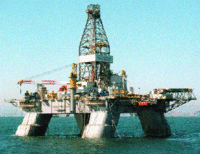-
Growing interest in prairie cordgrassas a biofuel source

Until recently, prairie cordgrass (Spartina pectinata) has received comparatively little attention because, unlike the other types of switchgrass, it is not a good forage crop; as interest in energy crops and in feedstock production for cellulosic biofuels increases, however, prairie cordgrass is receiving more attention because it grows well on marginal land
-
-
Loo turns poo into power
Researchers have invented a new toilet system that will turn human waste into electricity and fertilizers and also reduce the amount of water needed for flushing by up to 90 percent compared to current toilet systems
-
-
Greater L.A. to heat up an average 4 to 5 degrees by mid-century
A groundbreaking new study shows that temperatures in the Los Angeles region to rise by an average of 4 to 5 degrees Fahrenheit by the middle of this century, tripling the number of extremely hot days in the downtown area and quadrupling the number in the valleys and at high elevations
-
-
Significant sea-level rise in a 2-degree warming world
Sea levels around the world can be expected to rise by several meters in coming centuries, if global warming carries on; even if global warming is limited to 2 degrees Celsius, global-mean sea level could continue to rise, reaching between 1.5 and 4 meters above present-day levels by the year 2300
-
-
Finding the best ways to protect infrastructure, recover from disasters
Researchers at Sandia National Lab bring the quantitative methods they have developed to the analysis of disasters and how best to recover from them; the researchers look at interdependencies among systems and supply chains, the resilience of various systems, how infrastructure systems fail, cascading effects, and how results might differ if a series of disasters hits instead of just one; the Sandia researchers say they can better quantify the results of such resiliency studies by taking a mathematically rigorous approach to objective assessments
-
-
California coastal infrastructure at risk from rising sea levels
An exhaustive study by the National research Council finds projects that the sea level off most of California is likely to rise about one meter over the next century, an amount slightly higher than projected for global sea levels; this will place much of the state coastal infrastructure at risk, because significant development along the coast — such as airports, naval air stations, freeways, sports stadiums, and housing developments — has been built only a few feet above the highest tides; for example, the San Francisco International Airport could flood with as little as 40 centimeters of sea-level rise
-
-
Seeping Arctic methane to pose serious problems for Florida coastline

Large quantities of methane gas are buried under the Arctic permafrost; the melting of ice caps in the Arctic causes this gas to escape into the atmosphere through vents; until recently, cryosphere (frozen soil and ice) has served to plug or block these vents, but thawing conditions have allowed the conduits to open, and deep geologic methane now escapes; methane is a very strong greenhouse gas, and its presence in the atmosphere has grown three times faster than carbon dioxide since the industrial era
-
-
Larger role for renewable energy in U.S. future than previously thought

Renewable electricity generation from technologies that are commercially available today, in combination with a more flexible electric system, is more than adequate to supply 80 percent of total U.S. electricity generation in 2050 while meeting electricity demand on an hourly basis in every region of the country; new study finds that renewable generation could play a more significant role in the U.S. electricity system than previously thought
-
-
Water for central Everglades essential for reversing ecosystem's decline
Twelve years into a $13.5billion state and federal effort to save the Florida Everglades, little progress has been made in restoring the core of the ecosystem, says a new congressionally mandated report from the National Research Council; expedited restoration projects that improve the quality and amount of water in this area are necessary to reverse ongoing declines
-
-
House bill allows Border Patrol to ignore environmental, safety protections along borders

The House of Representatives passed a sweeping bill which would allow the Border Patrol to ignore dozens of environmental protection laws — among them the Wilderness Act and Endangered Species Act — on all federally managed land within 100 miles of the Mexico and Canada borders; supporters argue that the measure is necessary to give the border patrol more freedom to chase illegal immigrants and drug smugglers; critics charge that the measure has little, if anything, to do with border security, and more to do with opening federally managed land to exploitation by private businesses, or pandering to local political constituencies
-
-
Carbon capture and storage likely to cause earthquakes
Carbon capture and storage, or CCS, is a major component of the world’s greenhouse gas reduction strategy; to make a significant contribution to emission reduction, however, CCS would need to operate on a massive scale, potentially sequestering upward of 3.5 billion metric tons of CO2 each year; researchers say that the injection of massive quantities of CO2 would be likely to induce small temblors which would break the reservoirs’ seals and release the stored CO2 into the atmosphere
-
-
Exploring the Bermuda Triangle's swirling vortices

Researchers, funded by the Office of Naval Research, deployed twenty-one underwater probes to study vortices at the Bermuda Triangle; a vortex is a swirl of water that can be created in several ways, including water being pushed between land masses and then released into the open ocean; the oceanographers did well to lose only one of the underwater probes, considering they were studying the notorious Triangle
-
-
For safer offshore drilling, government should modify monitoring practices

Since the April 2010 Deepwater Horizon blowout and explosion, the federal government as well as the offshore oil and gas industry have been undergoing major changes, including the issuance of regulations requiring operators of offshore facilities to adopt and implement comprehensive Safety and Environmental Management System (SEMS) programs by 15 November 2011
-
-
Nuclear waste repositories in suburbia?
Finding sites for nuclear waste storage is a growing problem, with decision makers running into the “not in my back yard” problem; the demise of Nevada’s Yucca Mountain project is but the latest example; researchers find that acceptance of sites for spent nuclear fuel repository may well depend on gender and economic background: in Finland, at least, affluent men more often are more receptive to the idea of locating such facilities near their neighborhoods than women or disadvantaged people
-
-
Explaining extreme months
Two months in Midwest history — March 2012 and December 1889 — stand out as the warmest winter months in more than a century of weather records; scientists investigated why these months, separated by 123 years, were so exceptional
-
More headlines
The long view
How Climate Change Will Affect Conflict and U.S. Military Operations
“People talk about climate change as a threat multiplier,” said Karen Sudkamp, an associate director of the Infrastructure, Immigration, and Security Operations Program within the RAND Homeland Security Research Division. “But at what point do we need to start talking about the threat multiplier actually becoming a significant threat all its own?”
